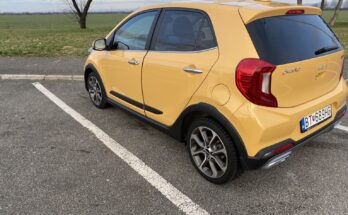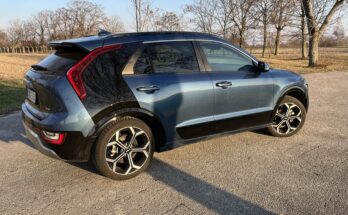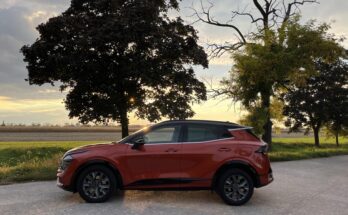I'm testing another crossover. Before taking over the car, I don't have exaggerated expectations, I'm rather skeptical, because crossovers of this class bring more negatives than positives in practice.
I was expecting a slightly raised chassis, modern unpainted plastic linings, chassis protection imitations and generally more aggressive body shapes. However, after receiving the car, I was surprised how sensitively the SUV elements I expected were incorporated into the exterior design. It is clearly one of the most beautiful cars in this category.
Creating a crossover from almost any model line is a simple and relatively cheap way to increase the number of brand models. Kia does not want to fall behind in this trend. She took the Rio as a basis and created the Stonic.
Since I haven't had the opportunity to test the Rio yet, I won't go into comparing its driving characteristics with the test model. I will focus on the Stonic as a separate model.
Strawberry in a black pot
However, I will not avoid a cursory comparison of the external design and dimensions of these "siblings". I'm not saying that the Rio isn't a nice car, but it feels bland and gets lost on the road among similar vehicles from other brands. Stonic has the exact opposite effect, especially if its owner embellishes it with the offered accessories or chooses a different color for the roof than the body itself. It looks like a class larger car, while its external dimensions differ only slightly from the Rio.
Despite its power, the car looks compact thanks to the short overhangs. The front mask looks unconventional with its full plastic covering. Engine cooling is unobtrusively ensured by a part of the bumper under the sign with the registration number. As is customary not only for the Kia brand, the front lights with LED signature extend into the sides of the body.
The heart-shaped front hood passes through the significantly lowered windshield, through the roof with interestingly shaped skids, ending with a gentle spoiler above the rear window. Simple doors with massive handles and prominent moldings on their lower part make the protruding fender stand out, which are perfectly filled with 17" wheels. The rear part of the car is excellently handled and, despite the significant plastic imitation of the chassis protection, it does not look tacky. I also like the admitted exhaust tip. Probably the only thing that bothers me about the exterior design is the shiny black plastic with embedded fog lights.
The distinctive red color in contrast with the black parts of the bumpers and fenders looks fresh. My wife's comment probably best describes her: "what an adorable strawberry in a black pot." I almost regretted testing the Stonic in this color.
Airy interior
At first glance, the interior looks pleasant and practical down to the details, all controls are within reach and in the right place. I have no reservations about the processing of the individual, although hard, plastic parts, nothing creaked or rattled during the ride. However, the use of softened plastics in this class is rather an exception.
The sporty shaped three-spoke steering wheel with multi-function buttons is excellent to hold and does not obscure the view of the instruments. The "alarm clocks" are a joy to look at, they are simple and clear, complete with a small TFT display. It provides information on consumption, range and driving time, and offers the option of setting safety and other systems when the vehicle is stopped. Like the recently tested Hyundai Kona, I appreciate the use of a good old coolant thermometer.
In the middle between the vents of the air conditioning, there is also a tablet of the multimedia system that is easy to read in the sun. The air conditioner is controlled by classic rotary controls, the problem is with its display, which is unreadable in the sun. There are plenty of storage spaces, but they lack fabric or at least rubber lining. Every object that is put down in them either flies from side to side or at least rattles unpleasantly.
I am generally satisfied with the interior. The only thing that surprised me a little is the design of the door, whose purely plastic surface looks a bit cheap. Replacement of a large, single-cast plastic surface, e.g. cloth upholstery would not cost much, but it would greatly benefit the interior. At the same time, this would also solve the hard armrest in the door.
I have to compare the seat behind the wheel with the recently tested Hyundai Kona, where it was a typical "SUV – chair". Tall, with legs lowered almost vertically down. Stonic is "different coffee". The driver's position is simply great. The steering wheel is adjustable in a significantly large range. The Stonic is one of the few cars where, at my height of 185 cm, I don't have to have the steering wheel set in the "closest and highest" position, and in both positions the steering wheel adjustment still had a reserve. I sit in the lowest possible position, legs stretched forward and the steering wheel pulled close to my body. I am sure that a driver of any size will find the ideal position. The interior space is generously designed, I would compare it to the average of the lower middle class. There is enough space for the legs, also at shoulder level. I could fit one more over my head.
In the back, you can already feel the spatial limitations. However, children and shorter people will not feel cramped. Installing the child seat is easy thanks to the well-placed IsoFix mounts. Families with small children would certainly welcome the padded back of the front seats.
I have a good feeling from the front seats. Due to the car's ground clearance of 183 mm, they are easy to get into. They are relatively wide for this class and reasonably hard with a long seat and backrest, but I miss the adjustable lumbar support. The armrest between the seats is soft and sliding.
The view from the vehicle is sufficient and supported by large rear-view mirrors. The luggage compartment with a volume of 332 l/1135 l was not a priority when designing the interior. However, part of the space is occupied by the spare wheel. The Hyundai-Kia concern is still not abandoning this solution.
Stonic on the way
The Kia was powered by the company's 1.6 CRDi diesel engine with a maximum output of 81 kW at 4,000 rpm and a torque of 260 Nm between 1,500 and 2,750 rpm. Personally, I think that diesel does not belong in cars intended for city traffic. However, after driving about 700 km, I changed my mind. However, not on the engine as such, but on the Kia Stonic as a city car, which is naturally related to the used engine.
After starting the car, it shakes slightly, the engine has a rougher running when cold, which softens only slightly after warming up. The sound of the engine penetrates into the cabin at low speeds, but it is nothing tragic. With a relatively light car (1349 kg), it doesn't have much to do. The response to the accelerator pedal is almost immediate, while the car reacts more violently only after pressing it more forcefully. The engine reacts best in the range of approx. 2300-3500 revolutions, while it does not choke even below 1500 revolutions. After 4000, it is useless to bother him. The car surprisingly "pulls" decently even when it needs to accelerate at highway speeds. If one does not expect sports performance from the car, the engine power is sufficient in all circumstances.
The clutch has a smooth and easy operation, and its frequent use in the city will not cause muscle fever in the left leg.
The manual transmission lever is located further back than I would like. It has quite accurate and easy operation, but longer tracks. The individual gears are graduated appropriately for driving in the city and on the highway.
The steering is precise and you can even feel hints of feedback. It doesn't feel artificial and the booster provides adequate resistance. The effect of the brakes could be dosed smoothly and did not decrease even with repeated braking on the highway.
For normal driving on a high-quality surface, the chassis seems ideal. When trying to drive more sportily, the car leans significantly in corners, but this does not prevent it from keeping track. However, any hint of understeer is nipped in the bud by the stabilization system. Despite the simple design, the rear axle does not bounce when cornering on bumps. However, it will give the crew a little feel for the poor road surface. Maybe it would be worth trying a different combination of dampers and springs for the next facelift. The relative Hyundai Kona filtered bumps better and leaned less.
Considering the price category and focus of the Stonic, however, I rate the driving characteristics as adequate.
Due to its appearance and dimensions, the tested car ranks among the "shopping bags". That's how I approached it from the beginning and I wasn't thrilled with the offered diesel under the hood. However, I changed my mind while traveling on the highway. The car is stable at higher speeds, I have nothing to complain about the steering. Aerodynamic noise is noticeable only at speeds above 140 km/h, and only from the front window. The chassis is relatively quiet even on rougher surfaces. The engine starts to sound more pronounced only after the limit of permitted highway speeds.
Longer and more time-consuming drives are pleasant and, due to the quiet and spacious interior, also comfortable. The bonus of a used engine when driving on the highway is its consumption.
In the city, thanks to its compact dimensions and small turning radius, the car is easy to maneuver and, with the assistance of the rear camera, also parks well. The raised chassis will help the view from the car and prevent damage to the chassis when it is necessary to overcome the curb. However, if I mainly use the car in these conditions, I would choose one of the offered gasoline engines.
Due to the front axle drive, I did not test the car in more difficult terrain, but it passed a short dirt road full of potholes without any problems thanks to the higher chassis.
I have traditionally tested the car in Bratislava and on the way from Bratislava to Vienna using district roads and highways in normal weekday traffic. I state the consumption according to the on-board computer data.
Driving on county roads will logically reduce fuel consumption to a minimum. I achieved 4.2 liters without trying to achieve a record. Driving on a rutted highway with frequent speed limits and heavy traffic while driving at a speed of 100-110 km/h increased consumption to 5.1. The on-board computer showed a value of 5.7 at a speed of 130 km/h and 6 liters at a speed of 140 km/h during smooth highway driving without the need for frequent braking and acceleration. Consumption when driving in Bratislava traffic jams in the style of brake-stop-gas-brake climbed to 8 liters. I did not manage to overcome this value even when trying to make maximum use of the engine's power. In combination, I drove for 5.4 l/100 km with the majority of highway transfers.
I rate the consumption as excellent in any driving mode, even if it differs from the declared average consumption of 4.2 l. The range for a full 45-liter tank is more than 800 km, which I consider sufficient.
Tablet
The settings of the multimedia system are intuitive and can be managed without the need to study the user manual. I was surprised by the excellent reception of Slovak FM and DAB stations even at a great distance from the border, on the other hand, the tinny sound of phone calls using the bluetooth module was a bit disappointing. I did not use the built-in navigation, Android Auto support allowed me to use Waze, which is hard to beat especially in the area of providing traffic information.
Platinum equipment
The price of the tested vehicle was €19,790 + €1,290 for the Platinium Pack + €490 for the metallics, while the Platinium Pack includes a number of safety systems. In my opinion, they could already be included in the basic equipment. Compared to similar models, I consider the price reasonable. Personally, I would pay an extra €450 for the Green or Orange Pack, which would improve the interior with a nicer steering wheel, seat covers and colorful accessories. The price list lacked the now common LED front lights and front parking sensors. In this model, the manufacturer does not offer a 4×4 drive in combination with any equipment or engine.
Kia provides a 7-year or 150,000 km warranty on most of its models, including the Stonic, with unlimited mileage for the first three years. The service interval is 20,000 km or one year.
Verdict
I was pleasantly surprised by the Stonic with a diesel engine. Considering the engine used, I can imagine it as a car for longer highway journeys. It will also play the role of a family car with smaller children, but it is necessary to expect a smaller luggage space. However, this model is mainly intended for those who appreciate fresh design and the possibility of color combinations. For the brave, the most suitable will be the Stonic in a distinctive yellow color with a black roof.
[rl_gallery id=”441″]



